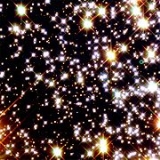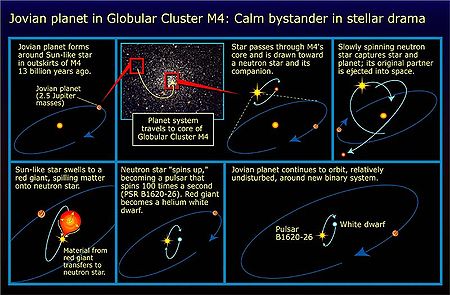
PSR B1620-26
Encyclopedia
PSR B1620-26 is a binary star
system located at a distance of 3,800 parsecs
(12,400 light-years
) in the globular cluster
of Messier 4
(M4, NGC 6121) in the constellation
of Scorpius
. The system is composed of a pulsar
(PSR B1620-26 A) and a white dwarf
(WD B1620-26
or PSR B1620-26 B). As of 2000, the system is also confirmed to have an extrasolar planet
orbiting the two stars.
companion, which was ejected when the current PSR B1620−26 B interacted with the original binary system. At that time, PSR B1620−26 B was still a main sequence
star, with its planet. Whereupon, the planet settled into orbit around both stars.
The triple system is just outside the core of the globular cluster. The age of the cluster has been estimated to be about 12.2 billion years. Hence this is the age estimate for the birth of the planet, and two stars.
There is a minor dispute about the proper nomenclature rules to use for this unusual star system. One side regards the A/B convention of naming binary stars as having priority, so that the pulsar is PSR B1620-26 A, the white dwarf companion is PSR B1620-26 B and the planet is PSR B1620-26 c. The other side considers PSR to only apply to stars which are pulsars, not their companions, so the white dwarf should be named using the WD convention, making the pulsar PSR B1620-26, the white dwarf "WD J1623-266", and the planet "PSR B1620-26 b." Early articles used the first convention, but star catalogs have been using the second. In practice, context makes it clear whether the pulsar, the white dwarf, the planet, or the system as a whole is being referred to.
 PSR B1620−26 b was originally detected through the Doppler shifts its orbit induces on signals from the star it orbits (in this case, changes in the apparent pulsation period of the pulsar).
PSR B1620−26 b was originally detected through the Doppler shifts its orbit induces on signals from the star it orbits (in this case, changes in the apparent pulsation period of the pulsar).
In the early 1990s, a group of astronomers led by Donald Backer, studying what they thought was a binary pulsar, determined that a third object was needed to explain the observed Doppler shifts. Within a few years, the gravitational effects of the planet on the orbit of the pulsar and white dwarf had been measured, giving an estimate of the mass of the third object that was too small for it to be a star. The conclusion that the third object was a planet was announced by Stephen Thorsett
and his collaborators in 1993.
Binary star
A binary star is a star system consisting of two stars orbiting around their common center of mass. The brighter star is called the primary and the other is its companion star, comes, or secondary...
system located at a distance of 3,800 parsecs
Parsec
The parsec is a unit of length used in astronomy. It is about 3.26 light-years, or just under 31 trillion kilometres ....
(12,400 light-years
Light-year
A light-year, also light year or lightyear is a unit of length, equal to just under 10 trillion kilometres...
) in the globular cluster
Globular cluster
A globular cluster is a spherical collection of stars that orbits a galactic core as a satellite. Globular clusters are very tightly bound by gravity, which gives them their spherical shapes and relatively high stellar densities toward their centers. The name of this category of star cluster is...
of Messier 4
Messier 4
Messier 4 or M4 is a globular cluster in the constellation of Scorpius. It was discovered by Philippe Loys de Chéseaux in 1746 and catalogued by Charles Messier in 1764. It was the first globular cluster in which individual stars were resolved.-Visibility:M4 is conspicuous in even the smallest of...
(M4, NGC 6121) in the constellation
Constellation
In modern astronomy, a constellation is an internationally defined area of the celestial sphere. These areas are grouped around asterisms, patterns formed by prominent stars within apparent proximity to one another on Earth's night sky....
of Scorpius
Scorpius
Scorpius, sometimes known as Scorpio, is one of the constellations of the zodiac. Its name is Latin for scorpion, and its symbol is . It lies between Libra to the west and Sagittarius to the east...
. The system is composed of a pulsar
Pulsar
A pulsar is a highly magnetized, rotating neutron star that emits a beam of electromagnetic radiation. The radiation can only be observed when the beam of emission is pointing towards the Earth. This is called the lighthouse effect and gives rise to the pulsed nature that gives pulsars their name...
(PSR B1620-26 A) and a white dwarf
White dwarf
A white dwarf, also called a degenerate dwarf, is a small star composed mostly of electron-degenerate matter. They are very dense; a white dwarf's mass is comparable to that of the Sun and its volume is comparable to that of the Earth. Its faint luminosity comes from the emission of stored...
(WD B1620-26
WD B1620-26
WD B1620-26 is a white dwarf star that orbits the pulsar PSR B1620-26 and both correspond with PSR B1620-26 planetary system. It is located in the Messier 4 globular cluster. The star is sometimes referred to as PSR B1620-26 B, though some consider this notation confusing as it implies that it is a...
or PSR B1620-26 B). As of 2000, the system is also confirmed to have an extrasolar planet
Extrasolar planet
An extrasolar planet, or exoplanet, is a planet outside the Solar System. A total of such planets have been identified as of . It is now known that a substantial fraction of stars have planets, including perhaps half of all Sun-like stars...
orbiting the two stars.
History
It is theorized that originally PSR B1620−26 A had another, lower mass white dwarfWhite dwarf
A white dwarf, also called a degenerate dwarf, is a small star composed mostly of electron-degenerate matter. They are very dense; a white dwarf's mass is comparable to that of the Sun and its volume is comparable to that of the Earth. Its faint luminosity comes from the emission of stored...
companion, which was ejected when the current PSR B1620−26 B interacted with the original binary system. At that time, PSR B1620−26 B was still a main sequence
Main sequence
The main sequence is a continuous and distinctive band of stars that appears on plots of stellar color versus brightness. These color-magnitude plots are known as Hertzsprung–Russell diagrams after their co-developers, Ejnar Hertzsprung and Henry Norris Russell...
star, with its planet. Whereupon, the planet settled into orbit around both stars.
The triple system is just outside the core of the globular cluster. The age of the cluster has been estimated to be about 12.2 billion years. Hence this is the age estimate for the birth of the planet, and two stars.
There is a minor dispute about the proper nomenclature rules to use for this unusual star system. One side regards the A/B convention of naming binary stars as having priority, so that the pulsar is PSR B1620-26 A, the white dwarf companion is PSR B1620-26 B and the planet is PSR B1620-26 c. The other side considers PSR to only apply to stars which are pulsars, not their companions, so the white dwarf should be named using the WD convention, making the pulsar PSR B1620-26, the white dwarf "WD J1623-266", and the planet "PSR B1620-26 b." Early articles used the first convention, but star catalogs have been using the second. In practice, context makes it clear whether the pulsar, the white dwarf, the planet, or the system as a whole is being referred to.
Planetary system

In the early 1990s, a group of astronomers led by Donald Backer, studying what they thought was a binary pulsar, determined that a third object was needed to explain the observed Doppler shifts. Within a few years, the gravitational effects of the planet on the orbit of the pulsar and white dwarf had been measured, giving an estimate of the mass of the third object that was too small for it to be a star. The conclusion that the third object was a planet was announced by Stephen Thorsett
Stephen Thorsett
Stephen Erik Thorsett is an American professor and astronomer. His research interests include radio pulsars and gamma ray bursts. He is known for measurements of the masses of neutron stars and for the use of binary pulsars to test the theory of general relativity...
and his collaborators in 1993.

